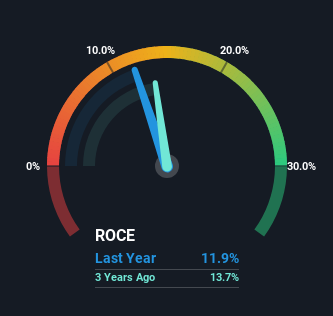Stock Analysis
- United States
- /
- Household Products
- /
- NasdaqGS:REYN
The Returns At Reynolds Consumer Products (NASDAQ:REYN) Aren't Growing

If we want to find a stock that could multiply over the long term, what are the underlying trends we should look for? Typically, we'll want to notice a trend of growing return on capital employed (ROCE) and alongside that, an expanding base of capital employed. Ultimately, this demonstrates that it's a business that is reinvesting profits at increasing rates of return. However, after briefly looking over the numbers, we don't think Reynolds Consumer Products (NASDAQ:REYN) has the makings of a multi-bagger going forward, but let's have a look at why that may be.
What Is Return On Capital Employed (ROCE)?
Just to clarify if you're unsure, ROCE is a metric for evaluating how much pre-tax income (in percentage terms) a company earns on the capital invested in its business. Analysts use this formula to calculate it for Reynolds Consumer Products:
Return on Capital Employed = Earnings Before Interest and Tax (EBIT) ÷ (Total Assets - Current Liabilities)
0.12 = US$512m ÷ (US$4.8b - US$478m) (Based on the trailing twelve months to December 2023).
Thus, Reynolds Consumer Products has an ROCE of 12%. In isolation, that's a pretty standard return but against the Household Products industry average of 21%, it's not as good.
Check out our latest analysis for Reynolds Consumer Products

In the above chart we have measured Reynolds Consumer Products' prior ROCE against its prior performance, but the future is arguably more important. If you'd like, you can check out the forecasts from the analysts covering Reynolds Consumer Products for free.
What Can We Tell From Reynolds Consumer Products' ROCE Trend?
Things have been pretty stable at Reynolds Consumer Products, with its capital employed and returns on that capital staying somewhat the same for the last five years. This tells us the company isn't reinvesting in itself, so it's plausible that it's past the growth phase. So don't be surprised if Reynolds Consumer Products doesn't end up being a multi-bagger in a few years time. This probably explains why Reynolds Consumer Products is paying out 48% of its income to shareholders in the form of dividends. Given the business isn't reinvesting in itself, it makes sense to distribute a portion of earnings among shareholders.
On a side note, Reynolds Consumer Products has done well to reduce current liabilities to 10.0% of total assets over the last five years. This can eliminate some of the risks inherent in the operations because the business has less outstanding obligations to their suppliers and or short-term creditors than they did previously.
The Bottom Line
We can conclude that in regards to Reynolds Consumer Products' returns on capital employed and the trends, there isn't much change to report on. And investors may be recognizing these trends since the stock has only returned a total of 12% to shareholders over the last three years. So if you're looking for a multi-bagger, the underlying trends indicate you may have better chances elsewhere.
On a final note, we've found 2 warning signs for Reynolds Consumer Products that we think you should be aware of.
While Reynolds Consumer Products isn't earning the highest return, check out this free list of companies that are earning high returns on equity with solid balance sheets.
Valuation is complex, but we're helping make it simple.
Find out whether Reynolds Consumer Products is potentially over or undervalued by checking out our comprehensive analysis, which includes fair value estimates, risks and warnings, dividends, insider transactions and financial health.
View the Free AnalysisHave feedback on this article? Concerned about the content? Get in touch with us directly. Alternatively, email editorial-team (at) simplywallst.com.
This article by Simply Wall St is general in nature. We provide commentary based on historical data and analyst forecasts only using an unbiased methodology and our articles are not intended to be financial advice. It does not constitute a recommendation to buy or sell any stock, and does not take account of your objectives, or your financial situation. We aim to bring you long-term focused analysis driven by fundamental data. Note that our analysis may not factor in the latest price-sensitive company announcements or qualitative material. Simply Wall St has no position in any stocks mentioned.
About NasdaqGS:REYN
Reynolds Consumer Products
Reynolds Consumer Products Inc. produces and sells products in cooking, waste and storage, and tableware product categories in the United States and internationally.
Solid track record and good value.

